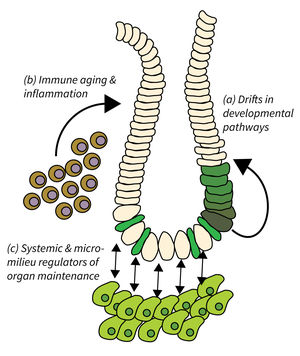Subarea 2: Regeneration and Homeostasis of Organs in Aging
The main goal of Subarea 2 is to identify cellular and molecular pathways used to ensure effective organ maintenance and repair, and to unravel the mechanisms of their deterioration during aging. While stem cells are important for organ homeostasis, this Subarea does not per se directly addresses stem cell aging but rather focusses on the following focus areas:
- Drifts in developmental pathways limiting organ maintenance in aging,
- Immune aging and inflammation, and
- Systemic and micro-milieu regulators of organ maintenance, regeneration, and disease development.
Research focus of Subarea 2
Organ maintenance is regulated by local and systemic factors, which are subject to aging-associated changes. Research of Subarea 2 focuses on the following research areas: a) Genetic and epigenetic modulation of developmental pathways has been shown to contribute to progressive aging and disease. It is critical to delineate mechanisms and consequences of aging-associated drifts to better understand organ maintenance during aging. b) Immunoaging and chronic inflammation elicits negative effects through reduced immune surveillance and aberrant organ repair and maintenance; all of which contributes to the evolution of organ pathologies and diseases during organismal aging. c) Furthermore, aging-associated alterations in systemic and extracellular factors derived from metabolic changes, microbiota alterations, chronic inflammation, senescent, or damaged cells might impinge on disease development and tumor initiation.
Publications
(since 2016)
2017
- Myofibroblasts have an impact on expression, dimerization and signaling of different ErbB receptors in OSCC cells.
Büttner R, Berndt A, Valkova C, Richter P, Korn A, Kosan C, Liebmann C
J Recept Signal Transduct Res 2017, 37(1), 25-37 - HMMR acts in the PLK1-dependent spindle positioning pathway and supports neural development.
Connell M, Chen H, Jiang J, Kuan CW, Fotovati A, Chu T, He Z, Lengyell TC, Li H, Kroll T, Li AM, Goldowitz D, Frappart L, Ploubidou A, Patel M, Pilarski LM, Simpson EM, Lange P, Allan DW, Maxwell CA
Elife 2017, 6, e28672 - RelB(+) Steady-State Migratory Dendritic Cells Control the Peripheral Pool of the Natural Foxp3(+) Regulatory T Cells.
Döhler A, Schneider T, Eckert I, Ribechini E, Andreas N, Riemann M, Reizis B, Weih F, Lutz MB
Front Immunol 2017, 8, 726 - ADAM Metalloprotease-Released Cancer Biomarkers.
Herrlich P, Herrlich A
Trends Cancer 2017, 3(7), 482-90 - OmoMYC blunts promoter invasion by oncogenic MYC to inhibit gene expression characteristic of MYC-dependent tumors.
Jung LA, Gebhardt A, Koelmel W, Ade CP, Walz S, Kuper J, von Eyss B, Letschert S, Redel C, d'Artista L, Biankin A, Zender L, Sauer M, Wolf E, Evan G, Kisker C, Eilers M
Oncogene 2017, 36(14), 1911-24 published during change of institution - Developmental stage-dependent regulation of spine formation by calcium-calmodulin-dependent protein kinase IIα and Rap1.
Koeberle SC, Tanaka S, Kuriu T, Iwasaki H, Koeberle A, Schulz A, Helbing DL, Yamagata Y, Morrison H, Okabe S
Sci Rep 2017, 7(1), 13409 - Ustilago maydis effectors and their impact on virulence.
Lanver D, Tollot M, Schweizer G, Lo Presti L, Reissmann S, Ma LS, Schuster M, Tanaka S, Liang L, Ludwig N, Kahmann R
Nat Rev Microbiol 2017, 15(7), 409-21 - Spindle Misorientation of Cerebral and Cerebellar Progenitors Is a Mechanistic Cause of Megalencephaly.
Li H, Kroll T, Moll J, Frappart L, Herrlich P, Heuer H, Ploubidou A
Stem Cell Reports 2017, 9(4), 1071-80 - Regulators of cell crosstalk crucial for bone mass
Liu P
Dissertation 2017, Ulm, Germany - Loss of menin in osteoblast lineage affects osteocyte-osteoclast crosstalk causing osteoporosis.
Liu P, Lee S, Knoll J, Rauch A, Ostermay S, Luther J, Malkusch N, Lerner UH, Zaiss MM, Neven M, Wittig R, Rauner M, David JP, Bertolino P, Zhang CX, Tuckermann JP
Cell Death Differ 2017, 24(4), 672-82









